2008 MERCEDES-BENZ SL ROADSTER ECU
[x] Cancel search: ECUPage 46 of 317

Occupant safety
43
R
in the event of ahead-on or rear-en dcolli-
sion if the vehicle decelerates or acceler-
ates rapidly in alongitudinal direction
during the initial stages of the impact
R in certain situation sifthe vehicle over-
turns, and the system determines that it
can provide additional protection
R on the front-passenger side only if the
front-passenger seat is occupied and the
belt tongue is engaged in the buckle
If the belt tensioners are triggered you will
hear abang, which will not cause any harm to
your hearing, and asmall amount of powder
may also be released. The 1warning lamp
lights up. G
Risk of injury
If the seat belt tensioners have been trig-
gered, they provide no additional protec-
tion in the event of another accident.
Therefore, have belt tensioners which have
been triggered replaced at aqualified spe-
cialist workshop.
Comply with safety regulations when dis-
posing of belt tensioners .Any Mercedes-
Ben zService Centr ecan provide details of
these regulations. Airbags Airbag deployment slows down and restricts
the movement of the vehicle occupant.
If the airbags are deployed you will hear a
bang, which will not cause any harm to your
hearing, and
asmall amount of powder may
also be released. The 1warning lamp
lights up.
The SRS/AIRBAG identification indicates the
location of the airbags. G
Risk of injury
Airbags provide additional protection ;they
are not ,however, asubstitute for the seat
belts.
Observe the following notes to reduce the
risk of serious or even fatal injury if an air-
bag is deployed:
R all vehicle occupants —inparticular preg-
nant women —must wear their seat belt
correctly at all times and lean back
against the backrest, which should be
positioned as close to the vertical as pos-
sible. The head restraint must support
the back of the head at about eye level.
R alway ssecure children less than 1.5 0m
tall or under 12 years of age in suitable
child restraint systems. R
all vehicle occupants must select aseat
position that is as far away from the air-
bag as possible. The driver's seat posi-
tion must allow the vehicle to be driven
safely. The driver's chest should be as far
away from the middle of the driver's front
airbag cover as possible.
R move the front-passenger seat as far
back as possible, in particular, if achild
is secured in achild restraint system on
the seat.
R vehicle occupants –inparticular, chil-
dren –must not lean their head on the
area of the window from which ahead/
thorax airbag is deployed.
R rearward-facing child restraint systems
must not be fitted to the front-passenger
seat unless the front-passenger fron tair-
bag has been disabled. The front-
passenger fron tairbag is disabled if a
child restraint system with automatic
child seat recognition is fitted to the
front-passenger seat. The
5 PASSENGER AIRBAG OFF warning
lamp must be constantly lit.
If you secure aforward-facin gchild
restraint system to the front-passenger Safety
230_AKB
;5;4,en-GB
bjanott, Version:2.9.6
2008-04-08T15:09:54+02:0
0-Seite 43 ZDateiname: 6515_3089_02_buchblock.pdf; preflight
Page 50 of 317
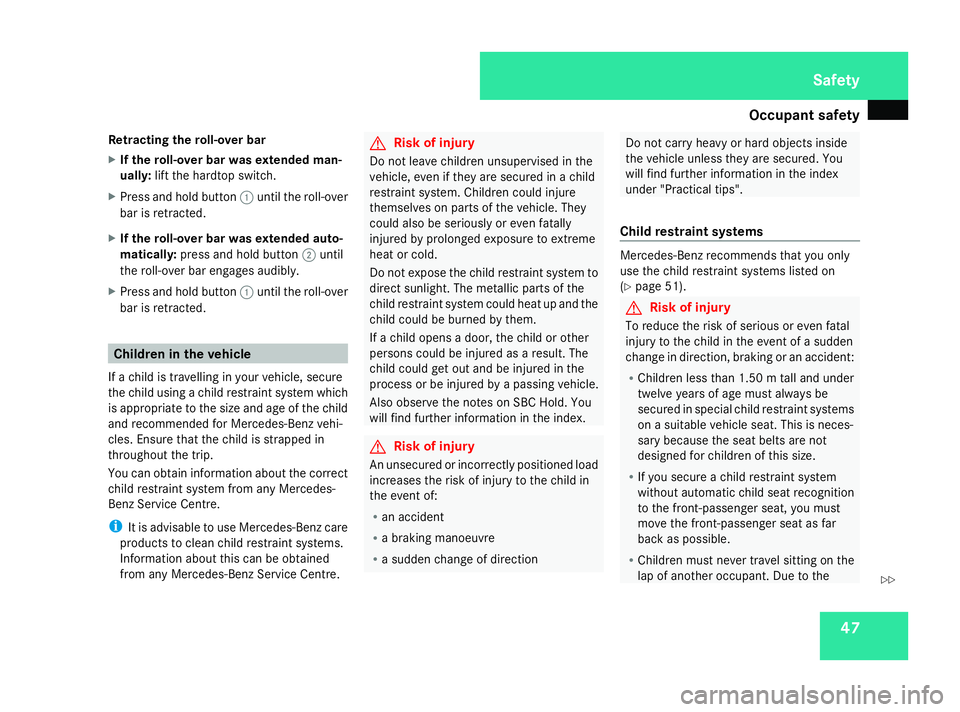
Occupant safety
47
Retracting the roll-over bar
X
If the roll-over bar was extended man-
ually: lift the hardtop switch.
X Press and hold button 1until the roll-over
bar is retracted.
X If the roll-over bar was extended auto-
matically: press and hold button 2until
the roll-over bar engages audibly.
X Press and hold button 1until the roll-over
bar is retracted. Children in the vehicle
If ac hild is travelling in your vehicle, secure
the child using achild restraint system which
is appropriate to the size and age of the child
and recommended for Mercedes-Benz vehi-
cles. Ensure that the child is strapped in
throughout the trip.
You can obtain information about the correct
child restraint system from any Mercedes-
Ben zService Centre.
i It is advisable to use Mercedes-Benz care
product stoclean child restraint systems.
Information about this can be obtained
from any Mercedes-Benz Service Centre. G
Risk of injury
Do not leave children unsupervised in the
vehicle, even if they are secured in achild
restraint system. Children could injure
themselves on parts of the vehicle. They
could also be seriously or even fatally
injured by prolonged exposure to extreme
heat or cold.
Do not expose the child restraint system to
direct sunlight .The metallic parts of the
child restraint system could heat up and the
child could be burned by them.
If ac hild opens adoor, the child or other
person scould be injured as aresult. The
child could get out and be injured in the
proces sorbei njured by apassing vehicle.
Also observe the notes on SBC Hold. You
will find further information in the index. G
Risk of injury
An unsecured or incorrectly positioned load
increases the risk of injury to the child in
the event of:
R an accident
R ab rakin gmanoeuvre
R as udden chang eofdirection Do not carry heavy or hard objects inside
the vehicle unless they are secured. You
will find further information in the index
under "Practical tips".
Child restraint systems Mercedes-Benz recommends that you only
use the child restraint systems listed on
(Y
page 51). G
Risk of injury
To reduce the risk of serious or even fatal
injury to the child in the event of asudden
chang eindirection, brakin goranaccident:
R Children less than 1.5 0mtall and under
twelve years of age must alway sbe
secured in special child restraint systems
on asuitable vehicle seat. This is neces-
sary because the seat belts are not
designed for children of this size.
R If you secure achild restraint system
without automatic child seat recognition
to the front-passenger seat, you must
move the front-passenger seat as far
back as possible.
R Children must never travel sitting on the
lap of another occupant. Due to the Safety
230_AKB
;5;4,en-GB
bjanott, Version:2.9.6
2008-04-08T15:09:54+02:0
0-Seite 47 ZDateiname: 6515_3089_02_buchblock.pdf; preflight
Page 51 of 317

Occupant safety
48 forces occurring in the event of
asudden
chang eofdirection, heavy brakin goran
accident, it would not be possible to
restrain the child. The child could be
thrown against parts of the vehicle inte-
rior and be seriously or even fatally
injured. G
Risk of injury
If the child restraint system is not correctly
fitted to asuitable vehicle seat, it cannot
perfor mits protective function .The child
cannot be restrained in the event of asud-
den chang eofdirection, heavy brakin gor
an accident. This may lead to serious or
even fatal injuries. For this reason, when
fitting achild restraint system, observe the
manufacturer's installation instructions
and the correct use of the child restraint
system.
The entire base of the child restraint system
must alway srest on the seat cushion.
Never place objects, e.g. acushion ,under
the child restraint system.
Only use child restraint systems with their
original covers. Only replace damaged cov-
ers with genuine Mercedes-Benz covers. For safety reasons
,you should only use
child restraint systems which have been
approved for use in Mercedes-Benz vehi-
cles.
Child seat on the front-passenger seat Warning on the front-passenger sun visor Warning symbol for
arearward-facing child
restraint system G
Risk of injury
If the front-passenger front airbag is not
disabled:
R ac hild secured in achild restraint system
on the front-passenger seat could be
seriously and even fatally injured by the
front-passenger front airbag deploying.
This is especially arisk if the child is in
the immediate vicinity of the front-
passenger front airbag when it deploys.
R ac hild must never be secured on the
front-passenger seat in arearward-facing
child restraint system.
R always move the front-passenger seat to
the rearmost position if you secure a Safety
230_AKB; 5; 4, en-GB
bjanott
,V ersion: 2.9.6
2008-04-08T15:09:54+02:00
-Seite 48 Dateiname: 6515_3089_02_buchblock.pdf; preflight
Page 77 of 317
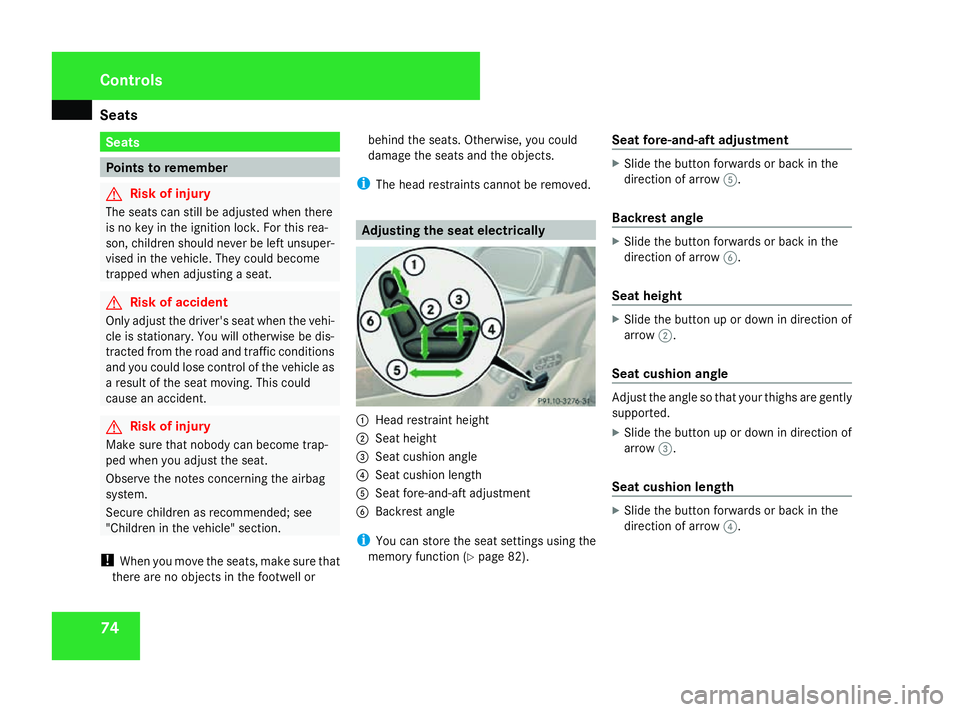
Seats
74 Seats
Points to remember
G
Risk of injury
The seats can still be adjusted when there
is no key in the ignition lock. For this rea-
son, children should never be left unsuper-
vised in the vehicle. They could become
trapped when adjusting aseat. G
Risk of accident
Only adjust the driver's seat when the vehi-
cle is stationary. You will otherwise be dis-
tracted from the road and traffic conditions
and you could lose control of the vehicle as
ar esult of the seat moving. This could
cause an accident. G
Risk of injury
Make sure that nobody can become trap-
ped when you adjust the seat.
Observe the notes concerning the airbag
system.
Secure children as recommended; see
"Children in the vehicle" section.
! When you move the seats, make sure that
there are no objectsint he footwell orbehind the seats. Otherwise, you could
damage the seats and the objects.
i The head restraint scannot be removed. Adjusting the seat electrically
1
Head restraint height
2 Seat height
3 Seat cushion angle
4 Seat cushion length
5 Seat fore-and-aft adjustment
6 Backrest angle
i You can store the seat settings using the
memory function (Y page 82). Seat fore-and-aft adjustment X
Slide the button forwards or back in the
direction of arrow 5.
Backrest angle X
Slide the button forwards or back in the
direction of arrow 6.
Seat height X
Slide the button up or down in direction of
arrow 2.
Seat cushiona ngle Adjust the angle so that yourt
highs are gently
supported.
X Slide the button up or down in direction of
arrow 3.
Seat cushionl ength X
Slide the button forwards or back in the
direction of arrow 4. Controls
230_AKB; 5; 4, en-GB
bjanott,
Version: 2.9.6
2008-04-08T15:09:54+02:00
-Seite 74 Dateiname: 6515_3089_02_buchblock.pdf; preflight
Page 87 of 317
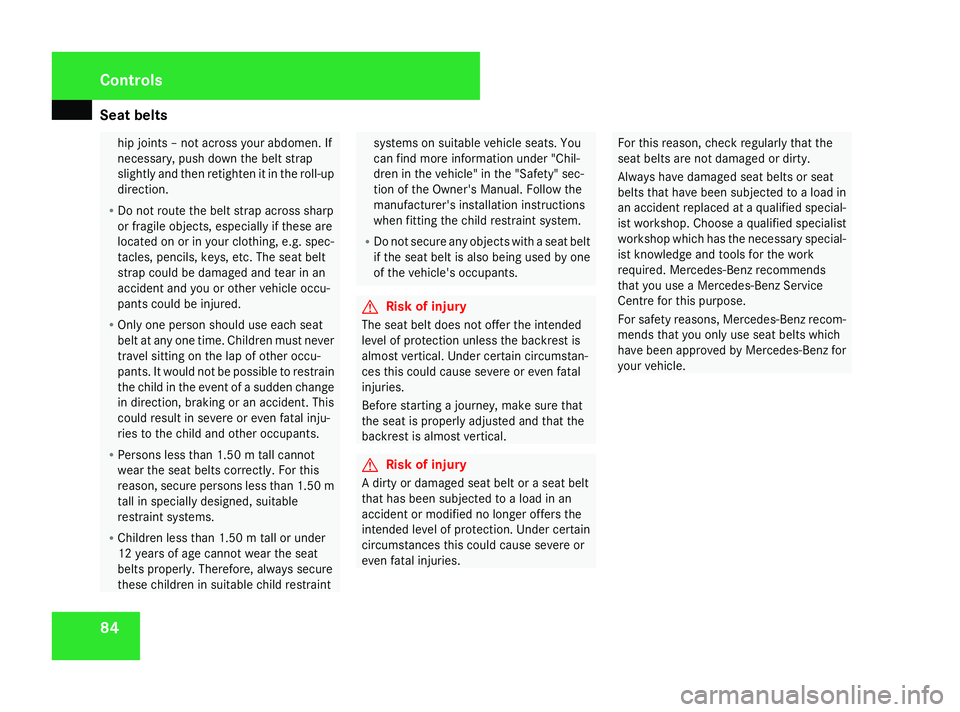
Seat belts
84 hip joints–n
ot across your abdomen. If
necessary, push down the belt strap
slightly and then retighten it in the roll-up
direction.
R Do not route the belt strap across sharp
or fragile objects, especially if these are
located on or in your clothing, e.g. spec-
tacles, pencils, keys, etc. The seat belt
strap could be damaged and tear in an
accident and you or other vehicle occu-
pants could be injured.
R Only one person should use each seat
belt at any one time. Children must never
travel sittingont he lap of other occu-
pants. It would not be possible to restrain
the child in the event of asudden change
in direction, braking or an accident. This
could result in severe or even fatal inju-
ries to the child and other occupants.
R Persons less than 1.50 mtall cannot
wear the seat belts correctly. For this
reason, secure persons less than 1.50 m
tall in specially designed, suitable
restraint systems.
R Children less than 1.50 mtall or under
12 years of age cannot wear the seat
belts properly. Therefore, always secure
these children in suitable child restraint systems on suitable vehicle seats. You
can find more information under "Chil-
dren in the vehicle" in the "Safety" sec-
tion of the Owner's Manual. Follow the
manufacturer's installation instructions
when fitting the child restraint system.
R Do not secure any objectsw ithaseat belt
if the seat belt is also being used by one
of the vehicle's occupants. G
Risk of injury
The seat belt does not offer the intended
level of protection unless the backrest is
almost vertical. Under certain circumstan-
ces this could cause severe or even fatal
injuries.
Before startingaj ourney, make sure that
the seat is properly adjusted and that the
backrest is almost vertical. G
Risk of injury
Ad irty or damaged seat belt or aseat belt
that has been subjected to aload in an
accident or modified no longer offers the
intended level of protection. Under certain
circumstances this could cause severe or
even fatal injuries. For this reason, check regularly that the
seat belts are not damaged or dirty.
Always have damaged seat belts or seat
belts that have been subjected to
aload in
an accident replaced at aqualified special-
ist workshop. Choose aqualified specialist
workshop which has the necessary special-
ist knowledge and tools for the work
required. Mercedes-Benz recommends
that you use aMercedes-Benz Service
Centre for this purpose.
For safety reasons, Mercedes-Benz recom-
mends that you only use seat belts which
have been approved by Mercedes-Benz for
your vehicle. Controls
230_AKB; 5; 4, en-GB
bjanott
,V ersion: 2.9.6
2008-04-08T15:09:54+02:00
-Seite 84 Dateiname: 6515_3089_02_buchblock.pdf; preflight
Page 88 of 317
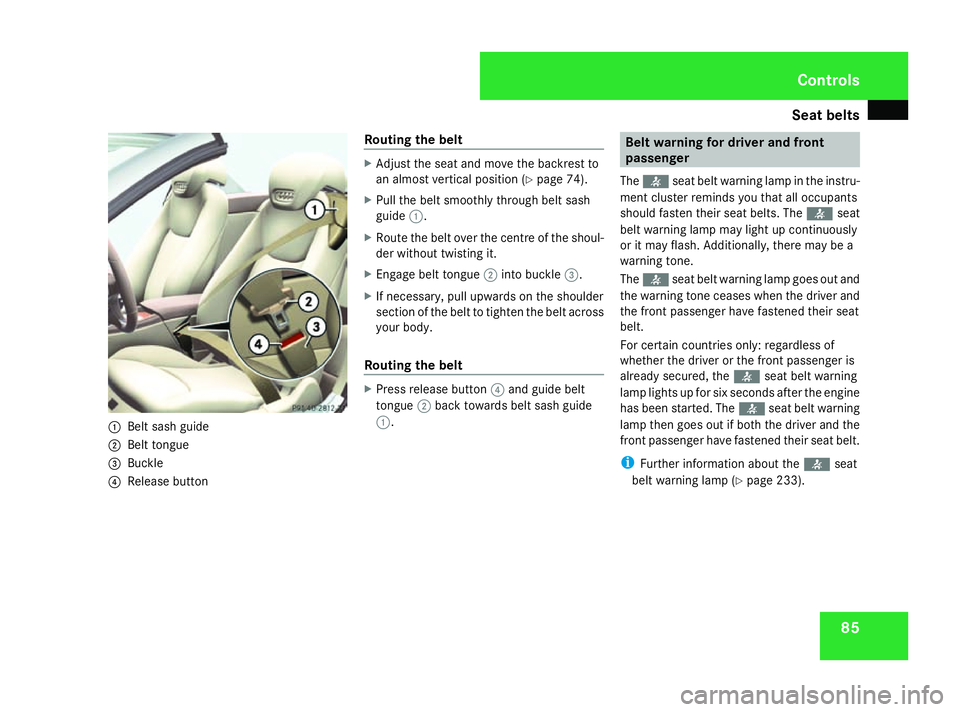
Seat belts
851
Belt sash guide
2 Belt tongue
3 Buckle
4 Release button Routing the belt X
Adjust the seat and move the backrest to
an almost vertical position (Y page 74).
X Pull the belt smoothly through belt sash
guide 1.
X Route the belt over the centreoft he shoul-
der without twisting it.
X Engage belt tongue 2into buckle 3.
X If necessary, pull upwards on the shoulder
section of the belt to tighten the belt across
yourb ody.
Routing the belt X
Press release button 4and guideb elt
tongue 2back towards belt sash guide
1. Belt warning for driver and front
passenger
The < seat belt warning lamp in the instru-
ment cluster reminds you that all occupants
should fasten their seat belts. The
or it may flash. Additionally,t here may be a
warning tone.
The < seat belt warning lamp goes out and
the warning tone ceases when the driver and
the front passenger have fastened their seat
belt.
For certain countries only: regardless of
whether the driver or the front passenger is
already secured, the
has been started. The
front passenger have fastened their seat belt.
i Further information aboutt he< seat
belt warning lamp (Y page 233). Controls
230_AKB; 5; 4, en-GB
bjanott,
Version: 2.9.6
2008-04-08T15:09:54+02:00
-Seite 85 ZDateiname: 6515_3089_02_buchblock.pdf; preflight
Page 97 of 317

Side windows
94 even if you are only leaving it for
ashort
time. G
Risk of injury
Do not leave children unsupervised in the
vehicle, even if they are secured in achild
restraint system. The children could:
R be seriously or even fatally injured on
parts of the vehicle
R be seriously or even fatally injured by
prolonged exposure to extremely high or
extremely low temperatures
If children open adoor, they could:
R seriously or even fatally injure other peo-
ple
R get out of the vehicle, thereby injuring
themselves or be seriously or even fatally
injured by apassing vehicle
The switches for all side windows are located
on the driver's door. There is also aswitch for the front-passenger side window on the front-
passenger door. 1
Front and rear, left
2 Front and rear, right
X Make sure that the key is in position 2in
the ignition lock.
i When the key is turned to position 0or
removed from the ignition lock, it is still
possible to operate the windowsu ntil the
driver's or front-passenger door is opened,
but for no longer than five minutes.
Opening/closing the front side win-
dows i
The front and rear side windowso pen
simultaneously if the roof is open. X
To open/close: press the switch down or
pullitupb eyond the pressure point and
hold it until the corresponding window is in
the desired position.
X To open/close fully: press the switch
down or pullitupb eyond the pressure point
and release it.
X To stop: briefly press the corresponding
switch down or pullitu p.
i You can use the soft-top switch in the
centre console to close all the side win-
dows at the same time.
Closing with increased force and without
the anti-entrapment feature G
Risk of injury
Make sure that nobody can become trap-
ped and possibly be seriously or fatally
injured as you close aside window with
increased force or withoutt he anti-entrap-
ment feature. Controls
230_AKB; 5; 4, en-GB
bjanott,
Version: 2.9.6
2008-04-08T15:09:54+02:00
-Seite 94 Dateiname: 6515_3089_02_buchblock.pdf; preflight
Page 98 of 317
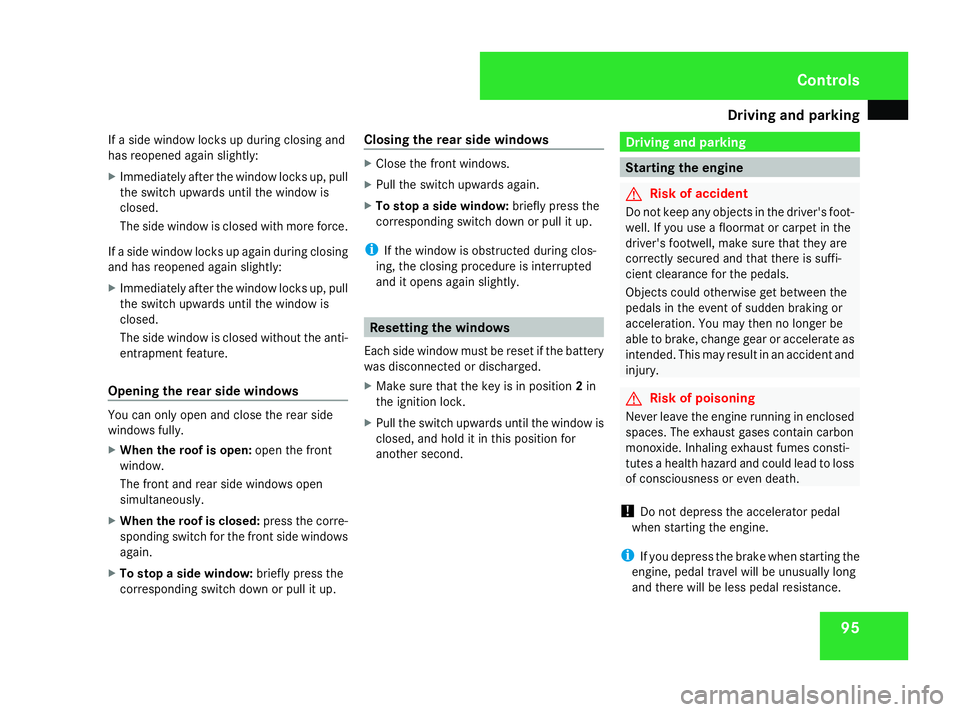
Driving an
dpark ing 95
If
as idew indo wl ocks up during closing and
ha sr eopened againsligh tly:
X Immediatel yafter the windo wlocks up ,pull
the switc hupwards until the windo wis
closed.
Th es idew indo wisc losedwithm oref orce.
If as idew indo wl ocks up agai ndurin gclosing
an dh asreopene dagain slightly:
X Immediatel yafter the windo wlocks up ,pull
the switc hupwards until the windo wis
closed.
Th es idew indo wisc losedwithout the anti-
entrapment feature.
Opening the rea rsidew indows Yo
uc an onlyopena nd close the rear side
windows fully.
X Whe nthe roo fiso pen: open the front
window.
Th ef ront an drears idew indows open
simultaneously.
X Whe nthe roo fisc losed: pressthe corre-
sponding switc hfor the front side windows
again.
X To sto pasidew indow: brieflypress the
corresponding switc hdownorp ullitu p. Closin
gthe rea rsidew indows X
Clos ethe front windows.
X Pull the switc hupwards again.
X To sto pasidew indow: brieflypress the
corresponding switc hdownorp ullitu p.
i If the windo wisobstructed during clos-
ing ,the closing procedure is interrupted
an dito pens agai nsligh tly. Resettin
gthe windows
Eac hsidew indo wm ustber esetif the battery
wa sd isconnected or discharged.
X Make sure tha tthe key is in position 2in
the ignition lock.
X Pull the switc hupwards until the windo wis
closed, an dholditint hisp osit ionf or
another second. Drivin
gand parking Starting th
eengine G
Risk of accident
Do no tkee pa ny objects in th edriver's foot-
well. If you use afloormat or carpet in the
driver's footwell, mak esuret hatthe ya re
correctl ysecure dand that there is suffi-
cien tclearanc efor thep edals.
Objects could otherwise get between the
pedals in th eevent of sudden braking or
acceleration .You may then no longer be
able to brake ,cha ng eg ear or accelerat eas
intended. Thi smay result in an acciden tand
injury. G
Risk of poisoning
Never leav ethe engin erunning in enclosed
spaces. The exhaus tgase scontai ncarbon
monoxide. Inhalin gexhaus tfumes consti-
tute sah ealth hazard and could lead to loss
of consciousness or eve ndeath.
! Do no tdepress th eaccelerator pedal
when startin gthe engine.
i If you depress th ebrake when startin gthe
engine, peda ltra ve lw ill be unusuall ylong
and there will be les speda lresistance. Cont
rols
230_AKB; 5; 4, en-GB
bjanott,
Version: 2.9.6
2008-04-08T15:09:54+02:00
-Seite 95 ZDateiname: 6515_3089_02_buchblock.pdf; preflight